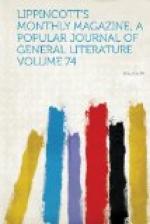[Illustration: CHEAT RIVER VALLEY AND MOUNTAINS.]
Descending the western slope of the mountains, we prick up our attention, although the grade is gradual and easy. We know that we are coming to the crowning glory of the ride, the region celebrated for its more than Arcadian beauty, and consecrated by the earliest glories of our war—by the mountain Iliad of McClellan, the initial action at Philippi, and the prompt trampling out of West Virginia secession by the victories of Cheat River. This tameless, mountain-lapped, hemlock-tinted river had long been our fancied cynosure. “Each mortal has his Carcassonne,” said, after a French poet, the late lamented John R. Thompson, using the term for what is long desired and never attained; and Mr. Matthew Arnold, in writing of a “French Eton,” says, “Whatever you miss, do not miss seeing Carcassonne.” As Carcassonne exists in French landscape, exists in the tourist’s mind and desire, a standard of beauty and historic suggestion, such to us had become this swart and noble river. Now it happens that Thompson has left a description, in his most polished prose, of glorious Cheat River. As our own powers of description are very inferior, we make no scruple of borrowing, or, as Reade calls it, “jewel-setting:” “The grandest achievement of the engineer (whose name, Benjamin H. Latrobe, should always be stated in connection with the road) is to be found, however, in the region of Cheat River, where to the unscientific eye it would appear almost impossible that a road-bed could ever have been built. For two miles beyond Rowlesburg, where the Cheat River is crossed on a massive bridge of iron, there is a continuous succession of marvels in railway-work, of which the Tray Run viaduct is a dream of lightness and grace, yet so firm in its welded strength that thousands of tons of merchandise pass over it daily without causing, the slightest oscillation of its airy arches. Here, too, the wonders of mechanical skill are placed in striking juxtaposition with the wonders of Nature, whose obduracy has been so signally overcome. The sense of security was heightened in our case by a furious storm which burst upon us. We were seated on the fender or’ cow-catcher,’ watching the majestic marshaling of the thunder-clouds over the mountain-tops, and enjoying to the full the excitement of the moment, when suddenly the wind blew a terrific gust, filling the air with dust and dry leaves, and threatening to carry us individually over the precipice. The train was stopped, and we sought shelter in the comfortable car, which then moved on through the driving floods that continued to descend for half an hour, forming cataracts on every side of us. But the water ran off harmlessly from the solid track, and our engine bade defiance to the tempest, which hurled huge branches of the trees into the angry abyss beneath. The triumph of Science over Nature was complete; and as the sinking sun threw a glow over the Glades where the clouds had parted, I think my companions caught some inspirations of the ’Poetry of the Rail-way.’”




